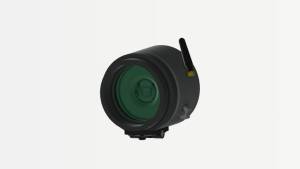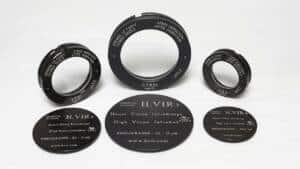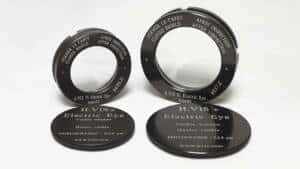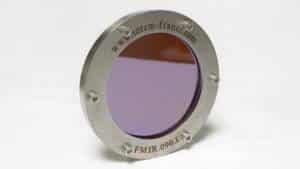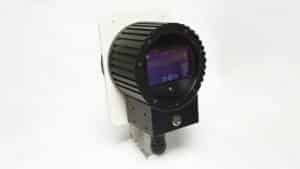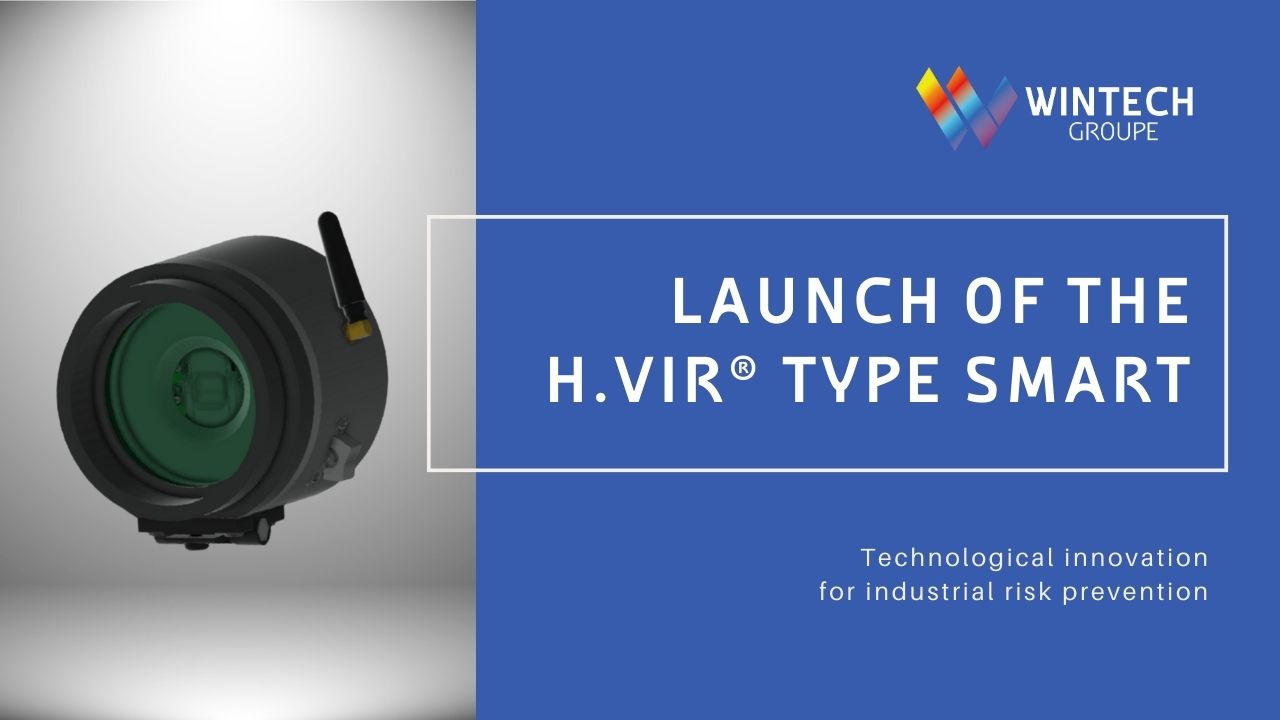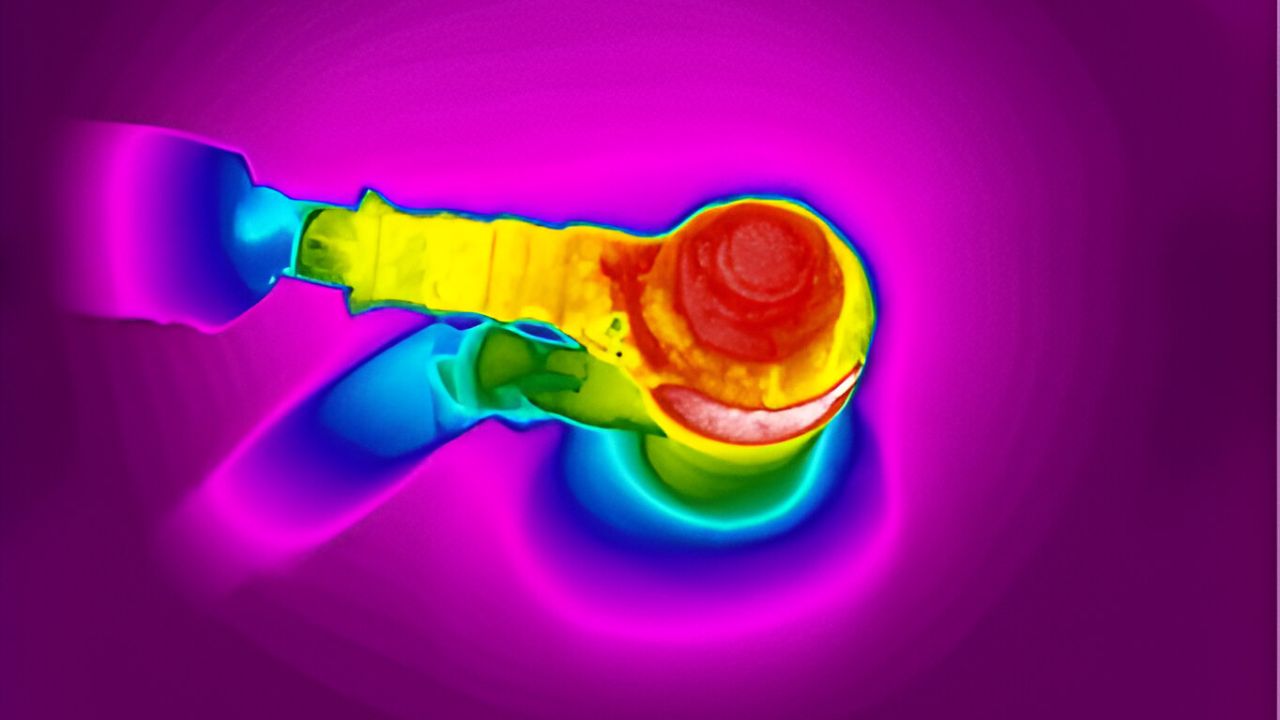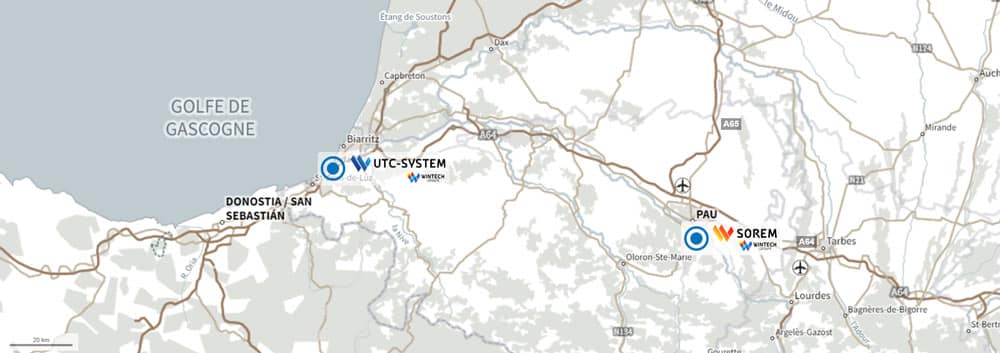What are the characteristics of optical window materials?
Optical windows are used for monitoring, observing or measurement purposes. They are commonly used by industry (aerospace, defense, medical, petrochemicals, etc.) and research players (laboratories, research institutes, engineering schools, etc.). To design an optical window, it is necessary to indicate precisely its application (conditions of use, spectral range, expected results) in order to determine which material will be most suitable for its design. Optical materials have very specific characteristics, this article will take you through them.
Overview of the main specificities of optical materials
To design an optical window there are three main categories of materials with different properties: glass, polymers and crystals. Each of these material families is composed of substrates with properties defined according to specific criteria such as transmission, refractive index and Knoop hardness. We offer a general description of the specifics of the most common substrates, followed by comparative tables on their optical transmission, refractive index and hardness.
N-BK7: the world’s most produced optical glass
The N-BK7 is characterized by its high homogeneity, low porosity and ease of machining. Its transmission range is from ultraviolet to shortwave infrared. The N-BK7 has good thermal stability. It is resistant to most non-fluorinated and non-alkaline chemicals but is sensitive to acids. N-BK7 has a low dispersion, which makes it suitable for spectroscopy. N-BK7 is relatively hard but can be susceptible to scratches.
Borosilicate: a material suitable for harsh environments
Borosilicate has a high thermal resistance. It is also characterized by low homogeneity and high porosity. It offers good optical transmission in most of the visible and near-infrared spectrum. Resistant to most chemicals, it can be used for applications with exposure to corrosive substances. Borosilicate is suitable for optical windows subjected to severe thermal conditions or harsh chemical environments.
Silica: suitable for high temperature applications
Silica is transparent in a wide spectral range from ultraviolet to infrared. Light travels relatively quickly through this material, which is also resistant to many chemicals. However, silica is sensitive to concentrated alkaline solutions. With excellent thermal stability, it withstands high temperatures without deforming or degrading noticeably. A hard material, silica is moderately resistant to scratches and wear.
Germanium: for infrared applications
Germanium is a metalloid that transmits about 45% between 2 and 14 μm at 45°C. From 100°C the transmission degrades slowly, and much more rapidly above 200°C. Exceeding 200°C results in near-fatal material failure. It is therefore not advisable to use it under these conditions. Germanium is often used in thermal imaging applications. Germanium is very often accompanied by anti-reflective coating in the 3-5 μm and 8-14 μm transmission ranges because this allows the reflection losses of the material to be almost completely suppressed. This adds an additional constraint not to exceed 120°C of use, as the treatments are not resistant to a higher temperature. Finally, there are also hard carbon or DLC treatments that give it increased transmission and mechanical resistance. This is usually in contact with the outside (protects against erosion, scratches, salty air, oxidation, etc.).
ZnSe: performance in the mid-infrared
Zinc selenium (ZnSe) is a crystalline material with moderate transmission (about 70%) in the near-infrared to thermal-wave infrared range. ZnSe does not exhibit significant hardness. It can be easily scratched or damaged. This material is sensitive to moisture and dirt contamination. The ZnSe can handle high power levels of infrared laser beams.
Multispectral ZnS: for multispectral conditions of use
Like ZnSe, multispectral zinc sulfide (ZnS) is also a crystal with excellent moderate transmission (about 70%) in the near-infrared to thermal-wave infrared range. This material can be used to design optical windows for different wavelengths. ZnS has a very moderate hardness. However, it has a high thermal resistance (to be used up to 750 °C). It is appreciated for its visible transmission characteristics.
CaF2 and BaF2 fluorinated crystals: for UV, visible and IR optical applications
Calcium fluoride (CaF2) has excellent optical properties in a wide transmission range: from ultraviolet to longwave infrared. This birefringent material, through which light propagates quite slowly, has a low to moderate dispersion, limiting chromatic aberrations. CaF2 is resistant to many chemicals but can be sensitive to some strong acids. It is suitable for high temperature applications. However, you still have to be careful because it is sensitive to thermal shocks. It is low in hardness and it is susceptible to scratches
Barium fluoride (BaF2) is transparent in a wide range of wavelengths, especially in the deep ultraviolet. Unlike CaF2, light travels relatively fast through BaF2. This material has a rather low dispersion. It is sensitive to moisture and strong acids. With good thermal stability, it can withstand moderate temperatures. It has a low hardness and is susceptible to scratches. Like CaF2, it is sensitive to thermal shock.
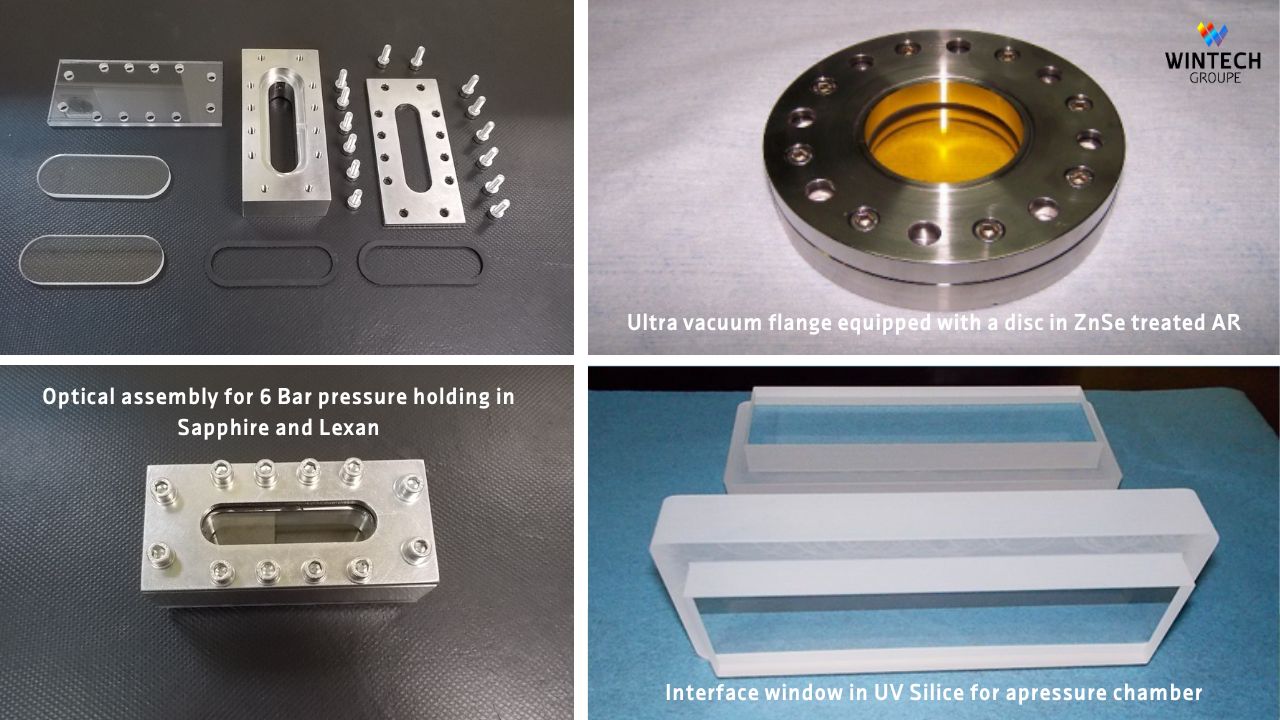
Quartz: highly resistant to chemically aggressive environments
Quartz is a crystalline material that can be used for optical applications covering a wide spectral area. It has a relatively low dispersion and minimal absorption. This material efficiently transmits light without significant heat dissipation. It is distinguished by a very high resistance to most chemicals (including strong acids and strong bases). With excellent thermal stability, quartz, a hard material, is resistant to high temperatures.
Sapphire: one of the hardest materials after diamond
Sapphire is a transparent crystalline material in a wide spectral wave range from visible to near-infrared. It is particularly transparent in the ultraviolet light. Sapphire is known for its high mechanical, thermal (up to 1000 °C) and chemical (including strong acids, strong bases) resistance. It has a relatively low dispersion. Light travels quite slowly through this material. Sapphire is extremely hard and resistant to scratches (erosion, abrasion, etc.). Its machining process requires the use of mastered techniques such as the use of ultrasonic technology.
Comparative Tables of Optical Materials: Transmission, Refraction and Hardness
Material Transmittance Rating for Optical Window
Transmission is the ability of the optical material to transmit light in a given wavelength (spectral range – ultraviolet, visible, infrared).
Summary of the Infrared Spectrum Split:
Near Infrared (NIR): 0.7 μm to 0.9 μm
Shortwave (SW): 0.9 μm to 2.5 μm
Medium wave (MW): 2 μm to 5 μm
Long waves or thermal waves: 8 μm to 14 μm
Far infrared: 14 to 100 μm

Refractive Index of Optical Window Materials
The refractive index determines how light deflects as it passes through the optical window. This index depends on the material and the wavelength of the light.
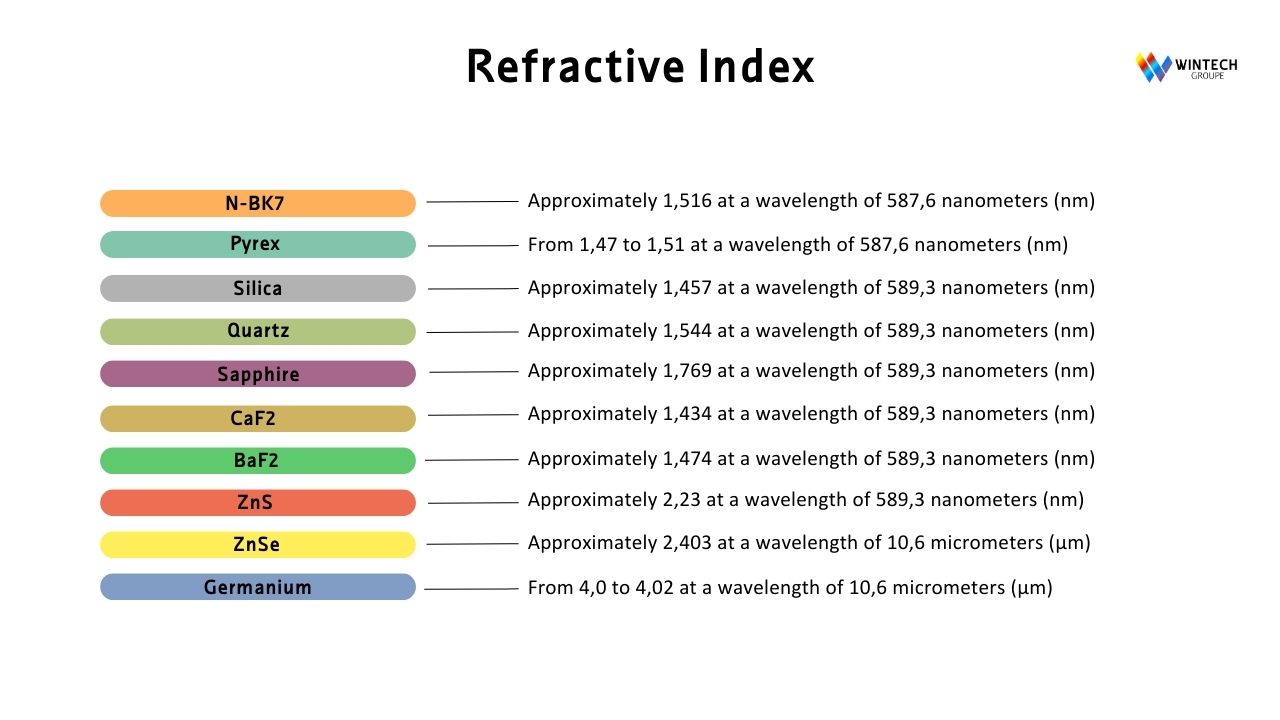
Knoop Hardness of Optical Window Materials
The higher the hardness of an optical material, the higher its mechanical strength or scratch resistance.
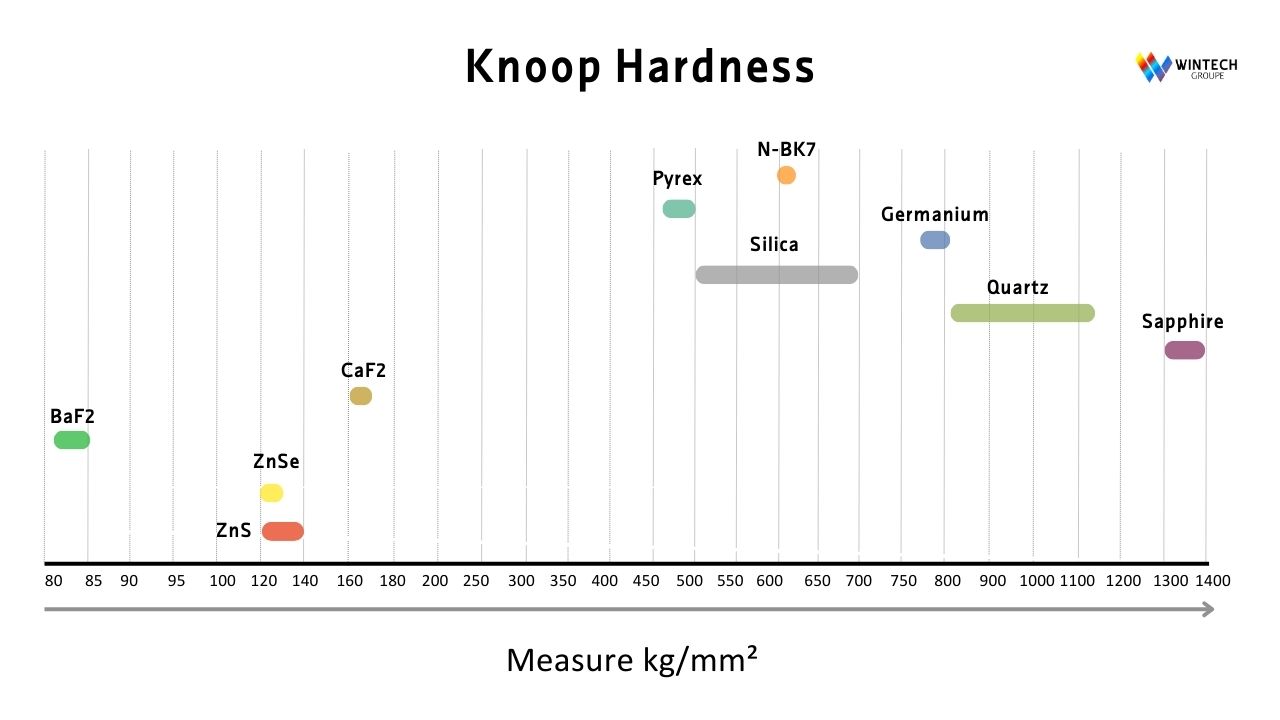
Optical windows are used for monitoring, observing or measurement purposes. They are commonly used by industry (aerospace, defense, medical, petrochemicals, etc.) and research players (laboratories, research institutes, engineering schools, etc.). To design an optical window, it is necessary to indicate precisely its application (conditions of use, spectral range, expected results) in order to determine which material will be most suitable for its design. Optical materials have very specific characteristics, this article will take you through them.
Overview of the main specificities of optical materials
To design an optical window there are three main categories of materials with different properties: glass, polymers and crystals. Each of these material families is composed of substrates with properties defined according to specific criteria such as transmission, refractive index and Knoop hardness. We offer a general description of the specifics of the most common substrates, followed by comparative tables on their optical transmission, refractive index and hardness.
N-BK7: the world’s most produced optical glass
The N-BK7 is characterized by its high homogeneity, low porosity and ease of machining. Its transmission range is from ultraviolet to shortwave infrared. The N-BK7 has good thermal stability. It is resistant to most non-fluorinated and non-alkaline chemicals but is sensitive to acids. N-BK7 has a low dispersion, which makes it suitable for spectroscopy. N-BK7 is relatively hard but can be susceptible to scratches.
Borosilicate: a material suitable for harsh environments
Borosilicate has a high thermal resistance. It is also characterized by low homogeneity and high porosity. It offers good optical transmission in most of the visible and near-infrared spectrum. Resistant to most chemicals, it can be used for applications with exposure to corrosive substances. Borosilicate is suitable for optical windows subjected to severe thermal conditions or harsh chemical environments.
Silica: suitable for high temperature applications
Silica is transparent in a wide spectral range from ultraviolet to infrared. Light travels relatively quickly through this material, which is also resistant to many chemicals. However, silica is sensitive to concentrated alkaline solutions. With excellent thermal stability, it withstands high temperatures without deforming or degrading noticeably. A hard material, silica is moderately resistant to scratches and wear.
Germanium: for infrared applications
Germanium is a metalloid that transmits about 45% between 2 and 14 μm at 45°C. From 100°C the transmission degrades slowly, and much more rapidly above 200°C. Exceeding 200°C results in near-fatal material failure. It is therefore not advisable to use it under these conditions. Germanium is often used in thermal imaging applications. Germanium is very often accompanied by anti-reflective coating in the 3-5 μm and 8-14 μm transmission ranges because this allows the reflection losses of the material to be almost completely suppressed. This adds an additional constraint not to exceed 120°C of use, as the treatments are not resistant to a higher temperature. Finally, there are also hard carbon or DLC treatments that give it increased transmission and mechanical resistance. This is usually in contact with the outside (protects against erosion, scratches, salty air, oxidation, etc.).
ZnSe: performance in the mid-infrared
Zinc selenium (ZnSe) is a crystalline material with moderate transmission (about 70%) in the near-infrared to thermal-wave infrared range. ZnSe does not exhibit significant hardness. It can be easily scratched or damaged. This material is sensitive to moisture and dirt contamination. The ZnSe can handle high power levels of infrared laser beams.
Multispectral ZnS: for multispectral conditions of use
Like ZnSe, multispectral zinc sulfide (ZnS) is also a crystal with excellent moderate transmission (about 70%) in the near-infrared to thermal-wave infrared range. This material can be used to design optical windows for different wavelengths. ZnS has a very moderate hardness. However, it has a high thermal resistance (to be used up to 750 °C). It is appreciated for its visible transmission characteristics.
CaF2 and BaF2 fluorinated crystals: for UV, visible and IR optical applications
Calcium fluoride (CaF2) has excellent optical properties in a wide transmission range: from ultraviolet to longwave infrared. This birefringent material, through which light propagates quite slowly, has a low to moderate dispersion, limiting chromatic aberrations. CaF2 is resistant to many chemicals but can be sensitive to some strong acids. It is suitable for high temperature applications. However, you still have to be careful because it is sensitive to thermal shocks. It is low in hardness and it is susceptible to scratches
Barium fluoride (BaF2) is transparent in a wide range of wavelengths, especially in the deep ultraviolet. Unlike CaF2, light travels relatively fast through BaF2. This material has a rather low dispersion. It is sensitive to moisture and strong acids. With good thermal stability, it can withstand moderate temperatures. It has a low hardness and is susceptible to scratches. Like CaF2, it is sensitive to thermal shock.

Quartz: highly resistant to chemically aggressive environments
Quartz is a crystalline material that can be used for optical applications covering a wide spectral area. It has a relatively low dispersion and minimal absorption. This material efficiently transmits light without significant heat dissipation. It is distinguished by a very high resistance to most chemicals (including strong acids and strong bases). With excellent thermal stability, quartz, a hard material, is resistant to high temperatures.
Sapphire: one of the hardest materials after diamond
Sapphire is a transparent crystalline material in a wide spectral wave range from visible to near-infrared. It is particularly transparent in the ultraviolet light. Sapphire is known for its high mechanical, thermal (up to 1000 °C) and chemical (including strong acids, strong bases) resistance. It has a relatively low dispersion. Light travels quite slowly through this material. Sapphire is extremely hard and resistant to scratches (erosion, abrasion, etc.). Its machining process requires the use of mastered techniques such as the use of ultrasonic technology.
Comparative Tables of Optical Materials: Transmission, Refraction and Hardness
Material Transmittance Rating for Optical Window
Transmission is the ability of the optical material to transmit light in a given wavelength (spectral range – ultraviolet, visible, infrared).
Summary of the Infrared Spectrum Split:
Near Infrared (NIR): 0.7 μm to 0.9 μm
Shortwave (SW): 0.9 μm to 2.5 μm
Medium wave (MW): 2 μm to 5 μm
Long waves or thermal waves: 8 μm to 14 μm
Far infrared: 14 to 100 μm

Refractive Index of Optical Window Materials
The refractive index determines how light deflects as it passes through the optical window. This index depends on the material and the wavelength of the light.

Knoop Hardness of Optical Window Materials
The higher the hardness of an optical material, the higher its mechanical strength or scratch resistance.



